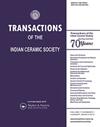Ceramic Manufacturing Workforce in India: Trends, Relative Earnings and Its Determinants
IF 1.5
4区 材料科学
Q3 MATERIALS SCIENCE, CERAMICS
引用次数: 0
Abstract
AbstractIndia’s ceramic industry, characterized by the transitional shift from traditional craft to modern industry, is imbibed to economic growth and development. It has witnessed a dynamic change from all hands-on deck to no hands-on deck. With an aim to understand the change in ceramic manufacturing workforce in India, the paper has analyzed the latest trends of ceramic workforce participation over the time period 1993-94 to 2020-21 using the national sample survey office (NSSO) employment and unemployment (E&U) survey data from 1993-94 to 2011-12 and periodical labour force survey (PLFS) data from 2017-18 to 2020-21. The results showcased that there was a declining trend in the overall workforce participation rate at the end of E&U survey (2011-12), however, after replacing NSSO E&U survey data with PLFS data the overall workforce participation rate showed an increasing trend. However, the study found that there was a continuous decline in the ceramic workforce as the total per cent of overall workforce. Further study highlighted that there is a wide gap between the perday earnings of ceramic and non-ceramic workers. Non-ceramic workers have high per day earning as compared to the ceramic workers that hampers the willingness of the workers to work in this industry. The study has established the impact of various socio-economic variables on per day earnings of the workers using Tobit regression model. The level of education has a positive and significant relation with per day earning of the ceramic workers. Education helps in accelerating the per day earning of the ceramic workers. Furthermore technical education have a highest positive impact on the per day earnings of the ceramic workers.Keywords: Ceramic workforceManufacturingTobit regression modelIndia印度陶瓷制造业劳动力:趋势、相对收入及其决定因素
【摘要】印度的陶瓷产业正处于由传统工艺向现代工业转型的转型期,其经济增长与发展与之密不可分。它见证了从全操作甲板到无操作甲板的动态变化。为了了解印度陶瓷制造业劳动力的变化,本文利用1993-94年至2011-12年的国家抽样调查办公室(NSSO)就业和失业(E&U)调查数据和2017-18年至2020-21年的定期劳动力调查(PLFS)数据,分析了1993-94年至2020-21年期间陶瓷劳动力参与的最新趋势。结果显示,在2011-12年E&U调查结束时,整体劳动力参与率呈下降趋势,而在用PLFS数据取代NSSO E&U调查数据后,整体劳动力参与率呈上升趋势。然而,该研究发现,陶瓷劳动力占总劳动力的比例持续下降。进一步的研究表明,陶瓷工人和非陶瓷工人的日收入差距很大。与陶瓷工人相比,非陶瓷工人的日收入较高,这阻碍了工人在该行业工作的意愿。本研究利用Tobit回归模型建立了各种社会经济变量对工人日收入的影响。文化程度与陶工日收入呈显著正相关。教育有助于加快陶瓷工人的日常收入。此外,技术教育对陶瓷工人的日收入有最高的积极影响。关键词:陶瓷劳动力制造业tobit回归模型印度
本文章由计算机程序翻译,如有差异,请以英文原文为准。
求助全文
约1分钟内获得全文
求助全文
来源期刊

Transactions of the Indian Ceramic Society
工程技术-材料科学:硅酸盐
CiteScore
2.40
自引率
8.30%
发文量
12
审稿时长
2.3 months
期刊介绍:
Transactions of the Indian Ceramic Society is a quarterly Journal devoted to current scientific research, technology and industry-related news on glass and ceramics. The Journal covers subjects such as the chemical, mechanical, optical, electronic and spectroscopic properties of glass and ceramics, and characterization of materials belonging to this family.
The Editor invites original research papers, topical reviews, opinions and achievements, as well as industry profiles for publication. The contributions should be accompanied by abstracts, keywords and other details, as outlined in the Instructions for Authors section. News, views and other comments on activities of specific industries and organizations, and also analyses of industrial scenarios are also welcome.
 求助内容:
求助内容: 应助结果提醒方式:
应助结果提醒方式:


